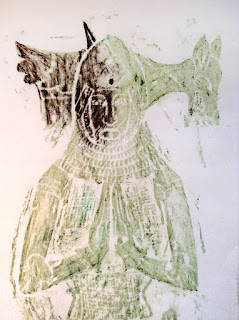Botanical artists are usually very accurate and controlled with their work. This time, however, they were painting the Pine Lines of The Brecks (Breckland) which lend themselves to a very much more looser creative, expressive style. And so that is what they did. Here is some of the tutor's work on display...
We started the day with a talk from Nick Gibbons, the former, now retired, Forestry Commission conservation officer, about the history of the Pine Lines and how they came to exist - they are such an 'unlikely' feature of the landscape!
Nobody really knows their true origins but from analysis, using historical maps and estate records, landscape historian, Prof. Tom Williamson, has suggested that many began life as a type of hedge, mainly used to mark perimeter boundaries but perhaps also to cause game birds to fly higher when flushed from 18th century hunting estates.
Today, hawthorn, a woody shrub, is more commonly used in the dry Brecks. In truth, Pines grow too fast and too large. They require a lot of maintenance to be used for hedging. Historically, since mediaeval-times, gorse, a yellow-flowering shrub, then known, rather confusingly as "furze", was used atop warren banks.
Given shrubs make for much better hedges, it is a mystery why anyone decided to plant pine trees instead, except for the fact that one or two nurseries began to promote Scots Pine around the time many of the Pine Lines were first being planted. It was a fad and a fashion for the landed-estates!
For a full history of the Brecks Pine Lines, here is the 2010 report produced by Prof. Tom Williamson of the University of East Anglia for Norfolk Biodiversity Partnership... "The Breckland Pine Rows: History, Ecology and Landscape Character".
All materials were provided (by a sponsor) and a quick demonstration over. Working from a selection of photographs supplied by our tutor, Sheila O'Brien, I selected an image which appealed to me and using pencil, marked it out very lightly onto the watercolour paper, concentrating mainly on the key elements of tree trunks and horizon...
Next came the job of starting to paint using watercolours, a medium I none too confident with. First, wet the paper with a clean sponge and lay in some colour over the sky. The board, is of course, angled towards you slightly such that the water will run down the page.
Here I used Ultramarine with a just a touch of Burnt Sienna (to mix to a neutral grey) where I wished to give the impression of cloud cover. Naples Yellow (a chalky opaque colour) and Lemon Yellow, with a touch of Burnt Sienna for warmth, were used for the landscape. Again a touch of Ultramarine Blue in the corner to indicate a tarmac road surface.
Without pencil to mark where to put the leaves, I have gone free-form! The tree canopy, usually very open and clumpy, is a blueish-green in the case of Scots Pine. I made this up with two colours blended wet-in-wet and applied wet-on-dry, with a large broad brush.
The sun-lit areas are Lemon Yellow with a touch of Ultramarine, laid down first. Into that, I added dabs and daubs of Indigo Blue mixed with just a touch of the opaque Naples Yellow to make it too, chalky and dense and shadowy.
Lunch break over..! Next, came the job of bringing it altogether. I forget to leave white paper for the tree-trunks. Using a small clean brush with clean water, I lifted out the required areas, as can be seen above.
The bark of the Scots Pine is a delightful pinkish-red colour which create that very distinctive appearance of the ancient pine woodlands of Scotland which are often accentuated by the early morning autumnal mists. It can be so pinkish that Burnt Sienna is perfect with little or no mixing. Here in Norfolk, in high-summer, the colour is strong and catches the sunlight, and the eye, creating great contrast. A touch of Indigo is a perfect mix for the darker shadows.
Finally, be brave! The cast shadows... A strong mix of a dark neutral, Burnt Sienna with Ultramarine. This anchors the trees to the ground and stops the appearance of them floating a few inches above it, which can look very surreal! It has also made for good contrast with the sun-lit landscape behind the trees, helping the illusion of strong sunshine.
My first watercolour for some time and I am really quite pleased! I have achieved some bright colours (water colour can be quite pale). I have created a looser feel to the image which is a departure from the accurate drawings botanical artists usually do, and which I once did with my detailed bird studies. I could very well image using this technique for field sketches. I do feel inspired.
Something that was so fascinating was seeing just how different everyone else's work was. At the end of the day, Everyone laid out their paintings on a table display and the tutor and co-ordinator selected works for future display, a nice surprise.
Mine was chosen among a few others, to be framed and shown at various sites later in the year to promote the workshops and the Breaking New Ground project which itself was design to promote and educate people about this lesser known English landscape.
Here is a small selection of other people's work I really, really liked..!
This last one, I especially like. It is so abstract and painted free hand without pencil guidelines. The colour are beautiful and the light and shade is just perfect. What a glorious image!






































